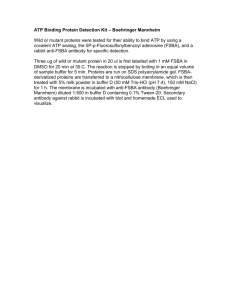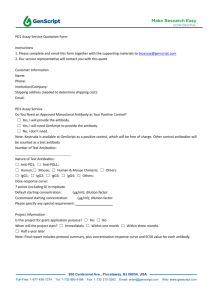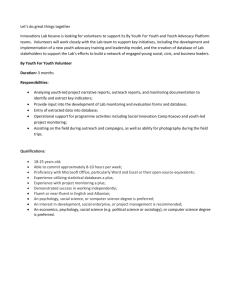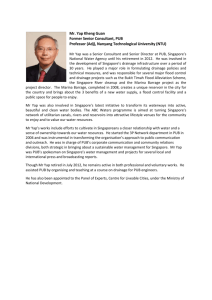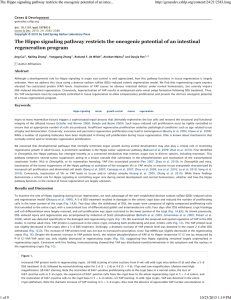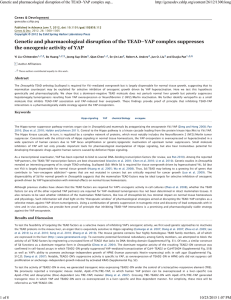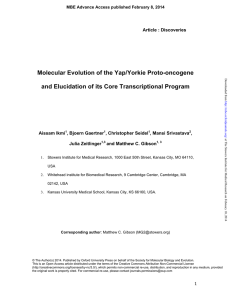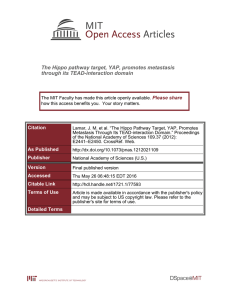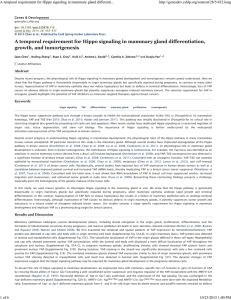Supplementary Information (doc 46K)
advertisement
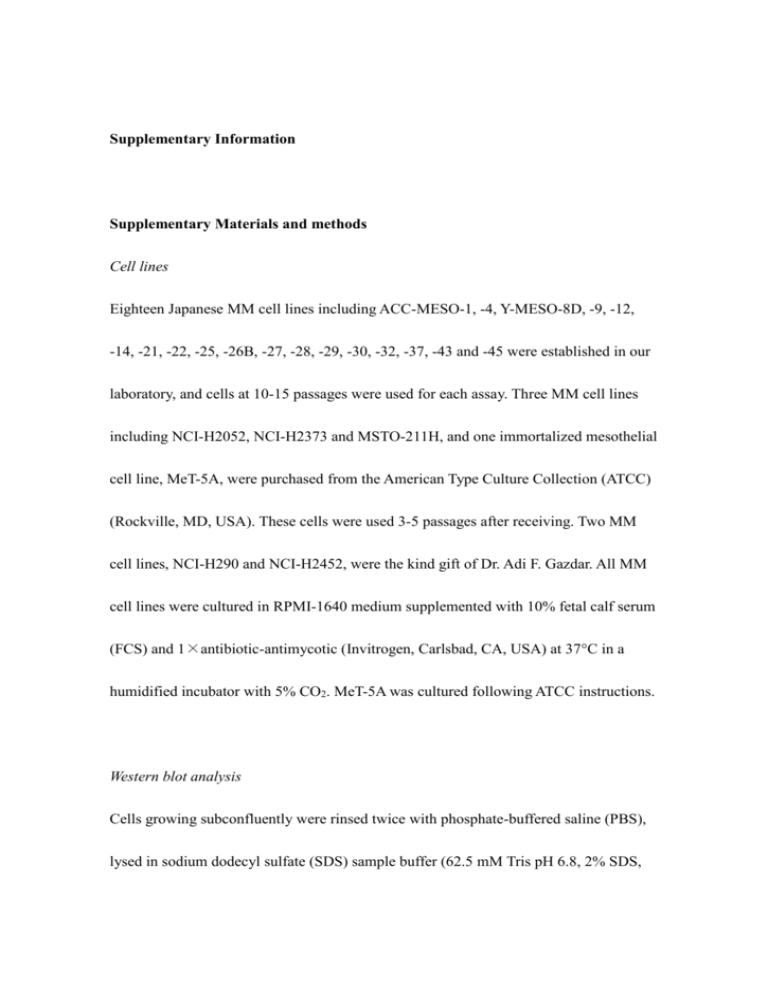
Supplementary Information Supplementary Materials and methods Cell lines Eighteen Japanese MM cell lines including ACC-MESO-1, -4, Y-MESO-8D, -9, -12, -14, -21, -22, -25, -26B, -27, -28, -29, -30, -32, -37, -43 and -45 were established in our laboratory, and cells at 10-15 passages were used for each assay. Three MM cell lines including NCI-H2052, NCI-H2373 and MSTO-211H, and one immortalized mesothelial cell line, MeT-5A, were purchased from the American Type Culture Collection (ATCC) (Rockville, MD, USA). These cells were used 3-5 passages after receiving. Two MM cell lines, NCI-H290 and NCI-H2452, were the kind gift of Dr. Adi F. Gazdar. All MM cell lines were cultured in RPMI-1640 medium supplemented with 10% fetal calf serum (FCS) and 1×antibiotic-antimycotic (Invitrogen, Carlsbad, CA, USA) at 37C in a humidified incubator with 5% CO2. MeT-5A was cultured following ATCC instructions. Western blot analysis Cells growing subconfluently were rinsed twice with phosphate-buffered saline (PBS), lysed in sodium dodecyl sulfate (SDS) sample buffer (62.5 mM Tris pH 6.8, 2% SDS, 2% 2-mercaptethanol, 10% glycerol) and homogenized. Thirty g of total cell lysate was subjected to SDS-polyacrylamide gel electrophoresis and transferred to polyvinylidene fluoride membranes (Millipore, Bedford, MA, USA). Followed by blocking with 3% non-fat dry milk, the membranes were incubated with the primary antibody, washed with PBS with 0.5% Tween 20, reacted with the secondary antibody, and then detected with ECL (Amersham Biosciences, Buckinghamshire, UK). Rabbit anti-YAP antibody (EP1674Y) was purchased from Abcam (Cambridge, UK), rabbit anti-phospho-YAP (S127) antibody (#4911) and mouse anti-CCND1 antibody (DCS6) were from Cell Signaling Technology (Danvers, MA, USA). Rabbit anti-FOXM1 antibody (SC502) was from Santa Cruz (Santa Cruz, CA, USA), and mouse anti-β-actin (clone AC74) from Sigma (St. Louis, MO, USA). Plasmid and RNA interference The cDNA fragments of wild- or mutant-type YAP and TEAD4 were amplified by PCR using PrimeSTAR Max DNA polymerase (Takara Bio, Otsu, Japan). YAP cDNA fragments were introduced into the pCMV-HA expression vector (Clontech, Mountain View, CA, USA), and TEAD4 cDNA fragments into pcDNA3.1 expression vector (Invitrogen). For luciferase reporter plasmids, the CCND1 promoter region 935 bps upstream and FOXM1 promoter region 1000 bps upstream were amplified and cloned into pGL3 basic luciferase reporter vector (Promega, Madison, WI, USA). Complementary short hairpin (sh) sequences were cloned into pLentiLox3.7 under control of the U6 promoter and transfected into HEK293FT cells along with the vectors of VSVG, RSV-REV and pMDLg /pRPE, to generate lentiviruses that transcribe shRNA. Two sh-YAP RNA interference lentivirus vectors (YAP-shN1 and YAP-shN2) contained each target sequence of the hairpin loop of YAP (shN1; 5’-TTCTATGTTCATTCCATCTCC-3’, shN2; 5’-GAGTTCTGACATCCTTAAT-3’). CCND1-sh and FOXM1-sh RNA interference lentivirus vectors were also constructed. Target sequences for CCND1 and FOXM1 are 5’-GGTGTCCTACTTCAAATGT-3’ and 5’- GCTGGGATCAAGATTATTA-3’, respectively. Control shRNA vectors were also constructed for luciferase (Luc-sh) with the target sequence for Luciferase (5’-CGTACGCGGAATACTTCGA-3’) and for YAP (YAP-scr1 and YAP-scr2) with each scrambled target sequence for YAP (scr1; 5’GGATAAACTAAGGGATAGGAA-3’, scr2; 5’- GAGTTCACTTCGATATCAT-3’). Cells were transduced with lentiviral vectors with a multiplicity of infection (MOI) of 10, incubated for an additional 6 h. Then the medium was exchanged for fresh RPMI-1640 medium with 5% FCS. Cells were incubated an additional 66 h. Expression profiling analyses 3.0×104 MM cells were seeded on flat-bottomed 24-well plates and grown in RPMI-1640 medium with 10% FCS. After 24 h, cells were transduced with lentiviral vectors with MOI of 10, incubated for an additional 6 h and then changed with 500 l RPMI-1640 medium with 5% FCS. After cells were incubated an additional 66 h, total RNA was extracted. Using 150 ng of total RNA, cRNA was generated and labeled with the Low Input Quick Amp Labeling Kit (Agilent Technologies) according to the manufacturer’s instructions. The cRNA from cells transduced with YAP-sh or control Luc-sh lentivirus were labeled with Cy5-CTP or Cy3-CTP, respectively. 825 ng of each labeled cRNA was mixed, and hybridizations were performed on 4×44 K oligonucleotide-based whole human genome microarrays (Agilent Technologies) at 65C for 17 h. After hybridization, arrays were washed and scanned with a G2505B Agilent DNA microarray scanner. Scanned images were analyzed with the Agilent Feature Extraction Program ver. 10.7. To investigate enrichment of our gene sets in the molecular network containing commonly downregulated or upregulated genes, KeyMolnet software was used to calculate a P-value using hypergeometric distribution. This algorithm for GO analysis is essentially based on that of the method developed by Boyle et al.: “GO::Term Finder-open source software for accessing Gene Ontology information and finding significantly enriched Gene Ontology terms associated with a list of genes.” (ref. 1). The significance in the similarity between the extracted network and the canonical network is scored according to the formula: In this equation, N is the total number of genes in the background distribution, M is the number of genes within that distribution that are annotated (either directly or indirectly) to the pathway of interest, n is the size of the extracted network and k is the number of genes within that network which are annotated to the pathway. The method is also applicable to significance analysis of gene sets defined by KeyMolnet including pathway analysis. Reference 1 Boyle EI, Weng S, Gollub J, Jin H, Botstein D, Cherry JM et al. GO::TermFinder--open source software for accessing Gene Ontology information and finding significantly enriched Gene Ontology terms associated with a list of genes. Bioinformatics 2004; 20: 3710-15. Supplementary Figure Legends Supplementary Figure 1 Western blot analysis of YAP and phosphorylated YAP at Ser127 using rabbit anti-YAP antibody and rabbit anti-phospho-YAP (S127) antibody in 23 MM cell lines and a transformed mesothelial cell line, MeT-5A. The ratio of intensities of pYAP/YAP in MeT-5A was arbitrarily set at 1.0. β-actin was used as the loading control. Supplementary Figure 2 Flow cytometry analysis with PE Annexin V apoptosis Detection Kit (BD Pharmingen, San Diego, CA) demonstrated that YAP knockdown by YAP siRNA induced a modest increase of cell population in early apoptotic phase in NCI-H290 cells compared to the control siRNA.
